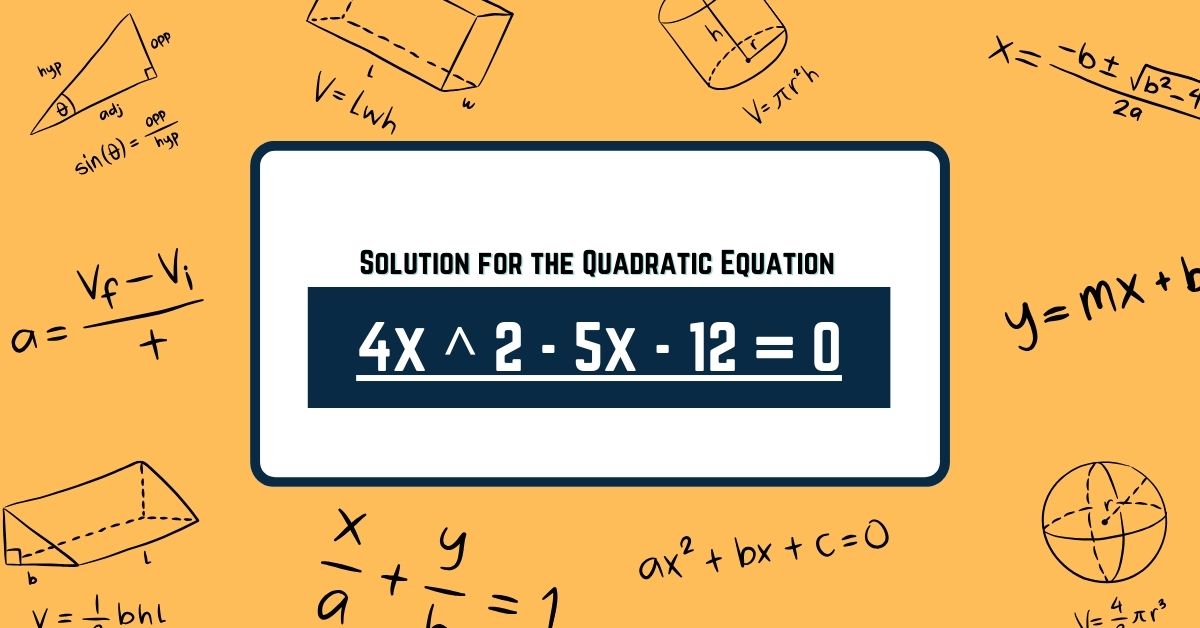Contents
Quadratic equations, which are of the form , plays a pivotal role in algebra and offers a window into understanding various mathematical phenomena. The equation 4x ^ 2 – 5x – 12 = 0 is an exemplary case for examining the methods and concepts involved in solving quadratic equations. This article aims to provide a thorough exploration of solving this specific equation, employing a variety of methods, interpretations, and graphical representations.
Introduction to Quadratic Equations
Quadratic equations describe parabolic curves in mathematics, encapsulating a wide array of physical scenarios and mathematical ideas. These equations are characterized by their highest exponent of 2, which results in their graphical representation as parabolas. The equation 4x ^ 2 – 5x – 12 = 0 stands as a prime example, illustrating the quintessential properties of quadratic equations and how they can be solved and analyzed.
The Quadratic Formula for 4x ^ 2 – 5x – 12 = 0
The most direct approach to solving quadratic equations is the quadratic formula, which provides a solution for in terms of the coefficients of the equation:
Applying the Formula to
For our equation, the coefficients are as follows:
- ,
- ,
- .
Substituting these values into the quadratic formula yields:
Thus, the equation has two real, distinct solutions:
These solutions reveal the x-coordinates where the parabola intersects the x-axis.
Exploring the Discriminant
The discriminant of a quadratic equation, given by b, plays a crucial role in determining the nature of its solutions:
- When b, the equation has two real and distinct solutions.
- If b, there is one real, repeated solution.
- For b, the solutions are complex or imaginary.
For 4x ^ 2 – 5x – 12 = 0, the discriminant is (), indicating two real and distinct solutions, as calculated above.
Graphical Interpretation and Analysis
The graphical representation of the quadratic equation 4x ^ 2 – 5x – 12 = 0 is a parabola opening upwards, due to the positive coefficient . This parabola’s vertex, the highest or lowest point depending on the opening direction, provides valuable information about the equation’s graph.
Vertex Calculation
The vertex of a parabola can be found using the formula , which in this case yields a specific point that represents the minimum or maximum of the equation. Additionally, the y-intercept is the point where the parabola crosses the y-axis, easily found by evaluating the equation at , giving us .
Solutions as Graphical Intersections
The solutions x and found earlier correspond to the points where the parabola intersects the x-axis. These points are crucial for understanding the parabola’s placement and orientation in the coordinate plane.
Must Read:
- Solve x2-11x+28=0 quadratic equations
- x2 + (y – 3√2x)2 = 1: Solving The Equation
- Solve x2-11x+28=0 quadratic equations
Conclusion
Solving quadratic equations like 4x ^ 2 – 5x – 12 = 0 not only provides specific numerical answers but also deepens our understanding of mathematical principles and their graphical representations. The quadratic formula is a powerful tool that, alongside discriminant analysis and graphical interpretation, offers comprehensive insights into the behavior of quadratic functions. Through these methods, we can appreciate the elegance and utility of quadratic equations in both theoretical and applied mathematics.



